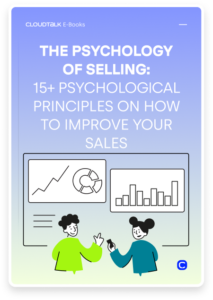4 ways in which an e-commerce contact center can help your e-commerce business

Struggling to take care of all your e-commerce business’ customers? Then an e-commerce contact center may be a huge help. Read on to find out how you can use them to boost your customer support.
The COVID-19 pandemic has changed almost all aspects of everyones’ lives, including our shopping habits. No one can predict when we will return to regular shopping in physical stores and shopping malls. Because of this, vast numbers of customers have turned to online shopping.
Globally, 49% of consumers now choose online stores more often than they did in the past, and 45% say they are now using their smartphones more often to shop. While plenty of customers mention that they miss visiting physical stores, many admit they like the speed and convenience of online stores.
If you run an e-commerce business yourself, you have probably already noticed a growing number of customers on your website. But having a lot of new traffic also brings some problems you may not have noticed before.
How can you respond to your customer questions quickly if you receive so many messages every day?
How can you provide the same exceptional customer support on all of the channels that your customers are now using?
And how can you make each customer feel valued and cared for?
Sell better with these psychological principles

The answer to those questions might be adopting the right contact center for e-commerce. Virtual contact center platforms can lend a hand to any e-commerce business that is struggling to keep their customer support running smoothly across all communication channels and their customers satisfied. And those platforms aren’t only useful for large call center teams – they also work exceptionally well for solving some modern e-commerce challenges. But let’s start by explaining what exactly is a virtual call center.
What are e-commerce contact centers?
Virtual contact center solutions are all-in-one contact platforms designed for all e-commerce businesses that want to improve their customer support while decreasing their staff’s workload. The main job of such platforms is to allow customer support agents to focus on providing exceptional customer support rather than juggling dozens of tools or completing several small but time-consuming daily tasks.
Let’s say that your customer support agents spend a lot of time each day searching through multiple files for customers’ personal data or purchase histories. This both frustrates the agents, especially if they have to search during calls, and the customers who have to wait. A virtual call center may be the solution to this problem. There’s no need to store customers’ data in multiple files as an e-commerce contact center gathers and stores all data about clients inside its database, which can be accessed by any agent in an instant even if they haven’t previously spoken to a given client.
An Interactive Voice Response menu, which is a key virtual call center tool, can also prove to be incredibly useful both for smaller e-commerce businesses and well-known brands. An IVR feature with an automatic call distribution system can handle dozens of incoming calls simultaneously and route them all to the right agent or department, preventing the need to transfer calls. But that’s not all it can do – IVR is also able to gather necessary customer data (such as ID) and answer simple questions, making support agents’ jobs easier, less stressful, and more productive.
But the biggest advantage of e-commerce stores and contact center tools is their flexibility. These software solutions are completely cloud-based, meaning that employees don’t need to be at the office desk in order to handle customers’ questions or issues. As long as they have a device with an internet connection, agents can log into the contact center platform from any place they wish and use it while working from home or a nearby coffee shop in the same as they would from the office.
4 biggest challenges for e-commerce customer support
What customers really want from all businesses right now, besides low prices, is high-quality customer support. In fact, not only do 65% of customers see the quality of customer service as a major factor when it comes to their shopping decisions, but 67% also said that great customer service encourages them to shop more often and/or spend more money.
But there’s quite a few factors that might get in the way of e-commerce companies offering exceptional customer support, such as too few staff, low productivity of agents, or lack of an omnichannel strategy and personalization. Virtual call center platforms might be just what e-commerce brands need to overcome those problems, though. Let’s look at the four most common problems in e-commerce customer support and how a contact center for e-commerce can be of help in this regard.
#1 Lack of staff in your e-commerce company
Customers are getting more demanding. Besides responding quickly to their questions or issues, they also expect companies to provide tailored offers matching their needs. But e-commerce businesses, especially small or new ones, often have problems handling increased amounts of orders and customer queries as they don’t have enough employees for customer support.
In such cases, try as they may, agents may fail to notice questions from new customers or take a long time to respond to an issue. And as customers can now usually find similar products on various other websites, delays like these may result in the company losing that customer.
Virtual contact center tools can act as an additional “employee” and for the take over some mundane daily tasks for support agents like gathering and updating data, tracking metrics, routing calls to the right agents, or recording calls. But there’s one more handy feature of those systems: during peak hours, when you need more agents to handle calls, you can add more people from other departments to the platform to back your team up. These draft-in agents will then have access to all the tools and data they need to support your main team for as long as they need.
#2 Low agent productivity
The more daily tasks an agent has on their list, the less time they are left with to properly care for their customers. And if they have to use multiple separate tools to complete those tasks, they will have even less time and energy for clients – especially if one of those tools hangs up or works slow. Moving the data from one tool to another often takes far too much time as well. How much easier would it be for your agents if they had all the necessary tools within one platform without having to switch back and forth between several different ones?
What’s more, with e-commerce contact center platforms, there’s no need to update customer data in several tools manually or inform other team members about any changes. After adding new customer data or updating the database, changes are immediately visible in all other tools within the platform. Besides making agents’ work far smoother, as they won’t need to frantically search for data about a particular customer, the caller won’t have to explain their problem or request several times either.
#3 Lack of an omnichannel strategy
While phones are still popular and useful as a support channel, relying completely on this one channel is nowhere near enough these days. Customers have several digital channels at their disposal now, and can pick one that is most convenient for them to use – whether that be email, live chat, or social media messaging. It isn’t unusual for customers to use several channels and regularly switch between them either. However, for e-commerce businesses, this means keeping track of all messages and responding to customers in the same way might be problematic.
Virtual call center tools can be of help here too. With them, agents can respond swiftly to questions or comments coming from multiple channels and provide the same exceptional customer support on each. And as all channels are connected, customers can freely switch between them without having to repeat themselves over and over. If a customer knows they can get in touch with a customer support agent through any channel they find convenient, it will naturally boost their satisfaction rate and, as a result, increase the number of times they return to that business in future.
#4 Lack of personalization
Besides getting a timely response to their questions, customers also expect all e-commerce companies to provide them with a personalized service. This means showing product recommendations or offers to customers that match their previous purchases, interests, and overall history with the company, as well as helpful customer support agents who know the client they are talking to. And, considering the huge amount of data e-commerce companies can gather with contact center tools, providing exceptional customer support is easier now than ever.
If your agents have all the relevant information about their customers right on their dashboards (such as past purchases, products they browsed but didn’t buy, or issues with which they reached out to support in the past), they can tailor their approach to make the customer feel truly special.
An IVR menu can be an incredible asset here as well, thanks to its automatic call distribution system. For example, you can divide your IVR menu into separate levels for different languages. How does it work? For example, let’s say that a caller needs to talk with someone in Spanish, and you have an agent who is fluent in this language. In the IVR menu, you can set an option for all customers who pick “For Spanish, press 5” to be redirected to an agent who can speak it and help the customer in their preferred language.
Conclusion
Competition in the e-commerce industry was tough enough before the pandemic and it is now several times fiercer, especially with increased customer expectations. Just offering the lowest prices on the market isn’t enough to attract customers, so giving them exceptional support is a must.
Implementing a virtual contact center solution like CloudTalk in your e-commerce business can lend you a hand with providing top-notch customer support. By using some of the 60+ features offered by this platform, your agents will have more time on their hands to take care of incoming questions and issues, as well as plenty of data available for them to give customers exactly the support they need. And as better customer support goes in hand with increased customer retention and satisfaction, providing the best support you possibly can is definitely worth the effort.
























